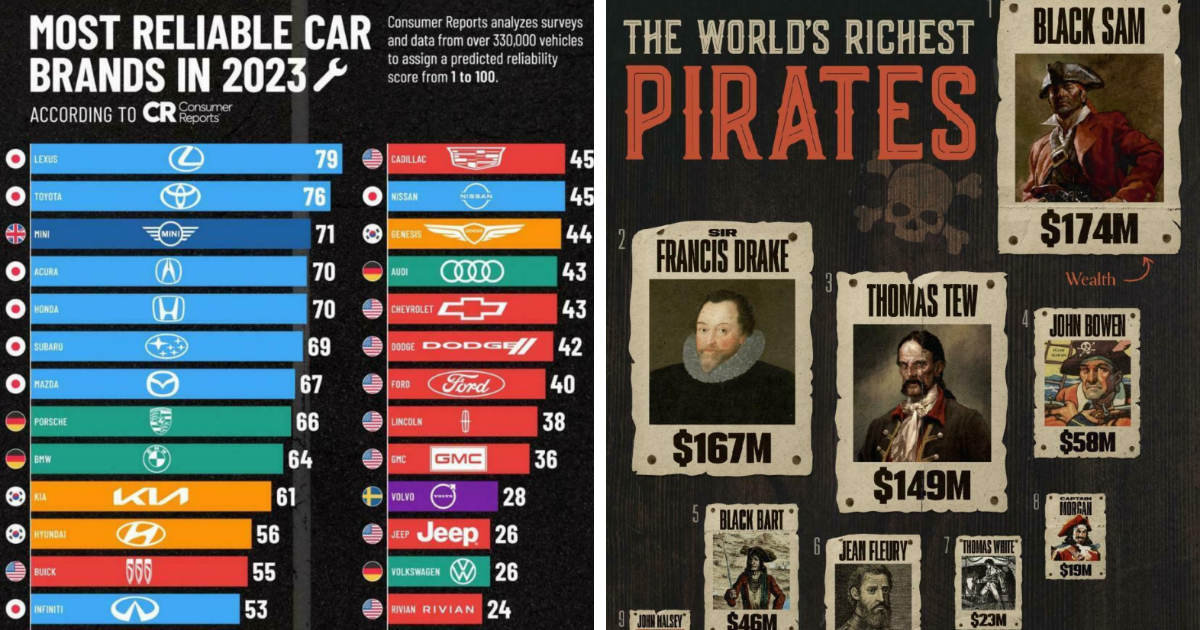85 Fun And Informative Charts About Parts Of The World You Might Not Have Seen Yet (New Pics)
Even if you have a wealth of informationit can be of little to no use when it’s presented in a complex way. Spreadsheets with what seem to be never-ending numbers and formulas are often overwhelming and off-putting, which lowers the chances of anyone engaging or delving deeper into them. But if we dress up data in clever and beautiful chartsthey instantly become inviting and impossible to ignore.
It’s a true art form to display information in a way that is clear and understandable, so we’re celebrating it by sharing charts that are both fascinating and stunning in hopes that they encourage you, our dear Pandas, to learn something new today. Scroll down to see them for yourself, and don’t forget to upvote the ones you found the most interesting!
if (!BoredPanda.Config.isTabletWidth) {
if (BoredPanda.Config.departments.includes(‘main-editorial’)) {
pdID = BoredPanda.Config.experimentVariation < 2 ? 118361 : 118363;
} else if (BoredPanda.Config.departments.includes('news')) {
pdID = BoredPanda.Config.experimentVariation < 2 ? 117965 : 117967;
} else {
pdID = BoredPanda.Config.experimentVariation < 2 ? 116845 : 120299;
}
} else if (BoredPanda.Config.isTabletWidth) {
if (BoredPanda.Config.departments.includes('main-editorial')) {
pdID = BoredPanda.Config.experimentVariation < 2 ? 118540 : 118541;
} else if (BoredPanda.Config.departments.includes('news')) {
pdID = BoredPanda.Config.experimentVariation < 2 ? 118537 : 118538;
} else {
pdID = BoredPanda.Config.experimentVariation < 2 ? 118535 : 120301;
}
}
if (BoredPanda.Config.bpVersion === 'news') {
pdID = 119689;
}
trfData = BoredPanda.TrafficSources.getData();
_subIdParts = [
BoredPanda.Config.postId,
BoredPanda.Config.pos.filter((t) => !t.includes('_')).join('_'),
trfData.source.replace(',', '').substr(0, 20),
trfData.medium.replace(',', '').substr(0, 20),
trfData.campaign.replace(',', '').substr(0, 20),
];
subId = _subIdParts.join(',');
if (!BoredPanda.Config.isMobileWidth) {
(function (d, s, b) {
var mElmt, primisElmt = d.createElement('script');
primisElmt.setAttribute('type', 'text/javascript');
primisElmt.setAttribute('async', 'async');
primisElmt.setAttribute('src', s);
var elmtInterval = setInterval(function () {
mElmt = d.getElementById(b);
if (mElmt) {
mElmt.parentNode.insertBefore(primisElmt, mElmt.nextSibling);
mElmt.parentNode.removeChild(mElmt);
return clearInterval(elmtInterval);
}
}, 20);
})(document, 'https://live.primis.tech/live/liveView.php?s=' + pdID + '&subId=' + subId + '&playerApiId=bpbase_desktop', 'desktop-widget-loaded');
}
Visualizing information, that is, turning it into charts, graphs, maps, etc., is an important skill to have for anyone nowadays, as it can be used in many contexts and fields.
“Knowing how to develop and deliver a data-driven presentation is now a crucial skill for many professionals, since we often have to tell our colleagues stories that are much more compelling when they’re backed by numbers,” agrees researcher and consultant Alexandra Samuel.
Almost any professional can make use of visual aids to understand data better themselves or make it more accessible to the general public or audience that doesn’t have the technical knowledge required to process it.
However, creating a clear presentation that visualizes data doesn’t just include putting a bar graph here and a pie chart there. That alone doesn’t guarantee a presentation that is easy to understand. To help professionals out, Harvard Business Review partnered with data and presentation experts to deliver a few pieces of advice on how to display your information like a pro.
The first tip they give is to make sure that your data can be seen. Sometimes what is readable on your laptop might not translate the same way when projected on a screen. Your audience won’t be interested or learn something they can’t see. So try to rehearse the presentation with someone seated from the screen as far away as the actual audience.
The following recommendation is to focus on the points that your data illustrates. Don’t leave your audience to decode the data presented to them.
“Data slides aren’t really about the data. They’re about the meaning of the data,” explains presentation design expert Nancy Duarte. “It’s up to you to make that meaning clear before you click away. Otherwise, the audience won’t process—let alone buy—your argument.”
Similarly, experts discourage sharing too many details at once. Present one, and they stress only one major point from each chart you show. To ensure that happens, ask yourself, “What is the single most important thing that I want my audience to take away from the data presented?”
Data-presentation guru Scott Berinato says, “The impulse is to include everything you know, [but] busy charts communicate the idea that you’ve been just that—busy, as in: ‘Look at all the data I have and the work I’ve done.’”
While crafting a chart, it’s also advised to clearly label its components. Having watched the visualization for a long time, everything might be clear to you, but the audience will look at it for mere seconds. In those seconds, they need to be able to understand the chart clearly. To achieve this, use simple, clear, and complete language to identify the X and Y axes, pie pieces, bars, and other elements included. Avoid abbreviations that might be confusing to others.
Over 65% of the population are visual learners, so catering to them is crucial and also contributes to the success of your presentation. An additional tip that appeases visual learners is highlighting what is called an ‘Aha!’ zone—a number or piece of information that is essential to the point you are trying to make. Explaining it out loud and writing it, and highlighting it in your chart helps to reinforce the most important data takeaways.
Lastly, experts advise presenting to your audience, not your data. People best receive the point you’re trying to make when you’re looking at them. Make critical points to your audience and only occasionally glance at your slides and data.
“When presented clearly and pointedly, data can elevate your point’s credibility and trustworthiness,” Harvard Business Review writes. “Presenting data poorly not only squanders that opportunity but can damage your reputation as a presenter. It’s a powerful tool to draw out compelling truths—wield it wisely.”





